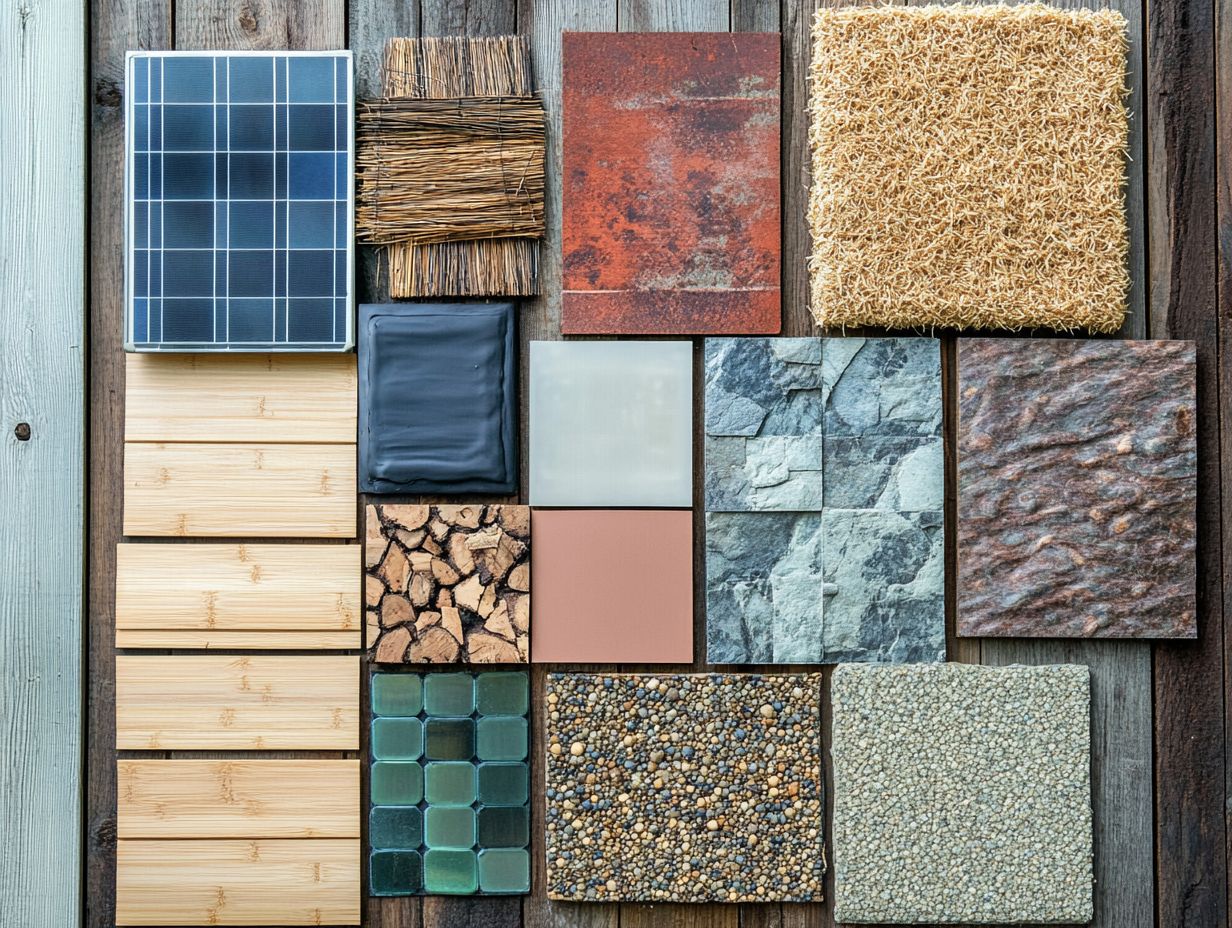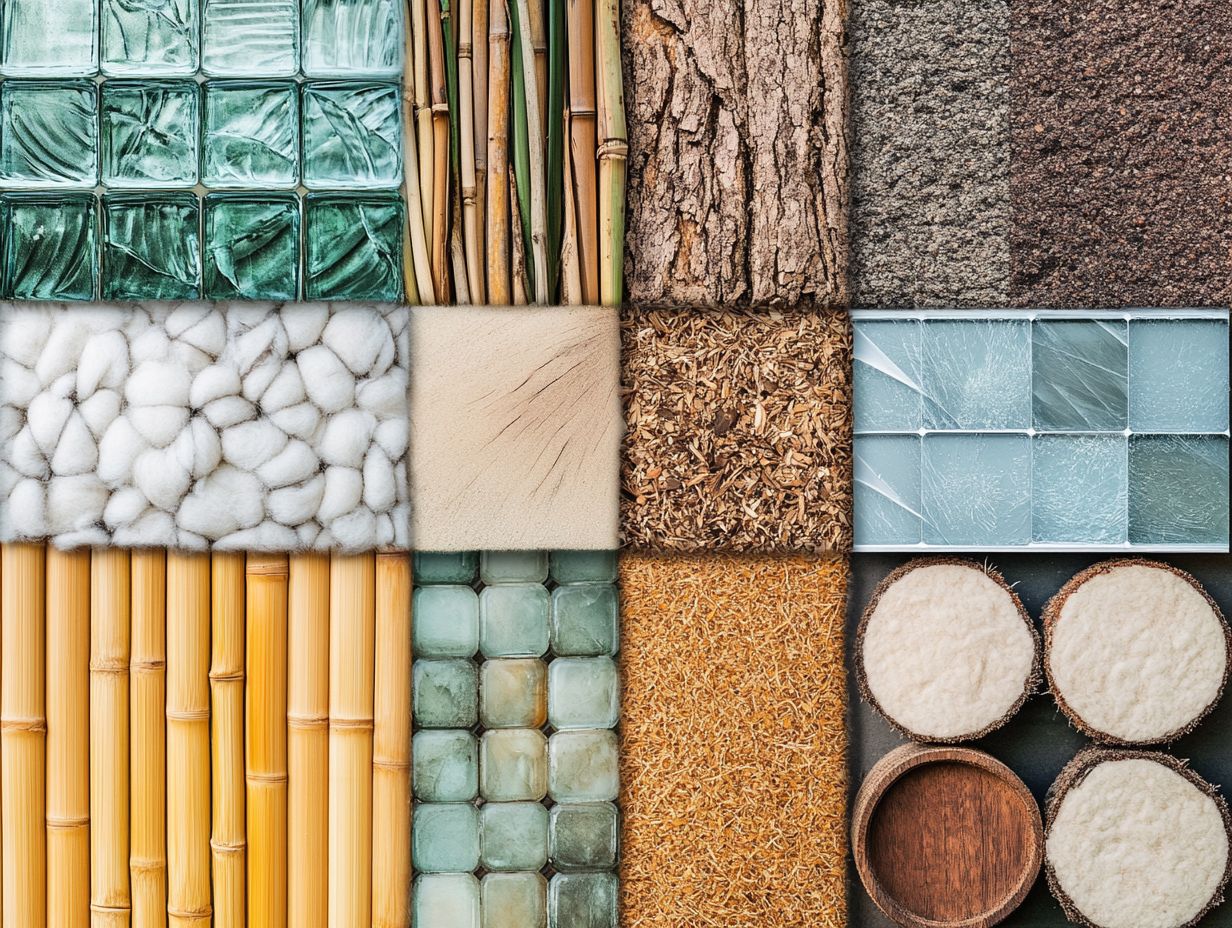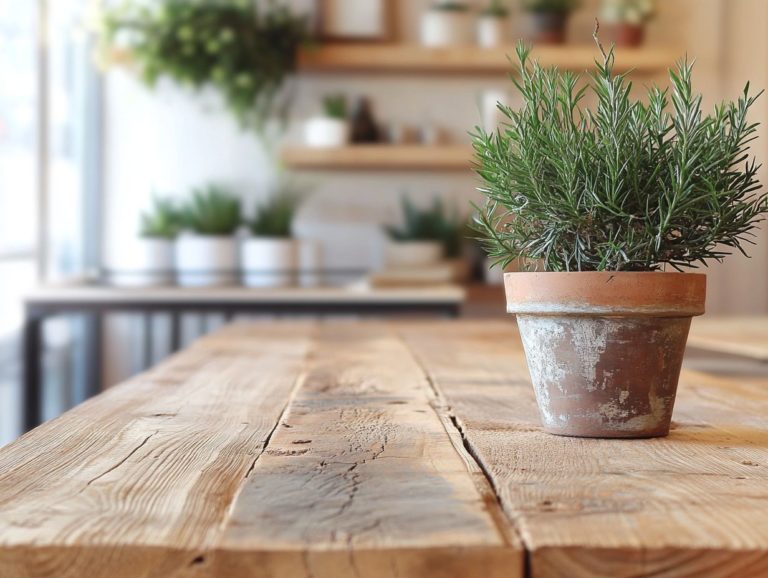5 Innovative Sustainable Materials for Homes
As you embark on the journey toward a greener future, the construction industry is unveiling innovative materials that not only elevate the aesthetic appeal of your home but also champion sustainability.
From the natural elegance of bamboo to the remarkable versatility of recycled plastic, this article delves into five game-changing materials that are redefining home building. You ll uncover their applications, benefits, and potential drawbacks while understanding how they contribute to reducing your carbon footprint.
Explore how you can make eco-friendly choices in your next construction project!
Contents
- Key Takeaways:
- 1. Bamboo
- 2. Recycled Plastic
- 3. Cork
- 4. Hempcrete
- 5. Reclaimed Wood
- What Makes These Materials Sustainable?
- Frequently Asked Questions
- What are 5 innovative sustainable materials for homes?
- How is bamboo used as a sustainable material for homes?
- What are the benefits of using recycled plastic in home construction?
- How does rammed earth contribute to sustainability in home building?
- What makes straw bales a sustainable building material?
- Can cork be used for more than just flooring in sustainable homes?
Key Takeaways:

- Bamboo is a fast-growing and renewable material that can be used for flooring, furniture, and even structural components in home construction.
- Recycled plastic can be transformed into durable and low-maintenance building materials, such as decking and roofing tiles, reducing waste and promoting a circular economy.
- Cork, known for its insulation and sound-absorbing properties, is a sustainable alternative to traditional flooring and can also be used as wall and ceiling coverings.
1. Bamboo
Bamboo stands out as an incredibly versatile and sustainable building material. It’s celebrated for its rapid growth, remarkable strength, and flexibility. This makes it perfectly suited for your eco-conscious design projects that aim to address the climate crisis and minimize environmental impact.
Its unique properties enable it to endure seismic activity. Additionally, its lightweight nature helps reduce transportation costs and energy consumption. When you compare bamboo to traditional building materials like steel and concrete, you ll find that it provides superior thermal insulation, leading to significant savings on heating and cooling expenses.
Bamboo is also naturally resistant to pests and has the capability to absorb carbon, solidifying its status as a champion of environmentally friendly practices.
Imagine the possibilities with bamboo it extends far beyond just basic structures! It s increasingly being utilized in furniture, flooring, and decorative elements, embodying a holistic approach to sustainability that you can proudly embrace.
2. Recycled Plastic
Recycled plastic has emerged as a game-changing material in sustainable architecture. It revolutionizes waste management and enables the creation of durable, eco-friendly construction products.
By transforming post-consumer plastic waste into valuable resources, this innovative approach addresses the pressing issue of plastic pollution while supporting a circular economy. The process typically begins with collecting and sorting discarded plastics, which are then cleaned and processed into raw materials suitable for manufacturing.
These materials find their way into a variety of construction applications, including composite decking, insulation, and even bricks. Utilizing recycled plastic allows you to minimize landfill contributions, offers significant cost savings, and enhances the lifespan of structures. It’s truly a win-win for both the environment and the construction industry.
3. Cork
Cork is a remarkable renewable resource that boasts impressive insulation properties, making it an ideal choice for eco-friendly construction and sustainable design. By opting for cork, you can significantly reduce energy costs and lessen your environmental impact.
You source cork from the bark of cork oak trees. This natural material not only helps maintain comfortable indoor temperatures but also serves as an effective sound barrier. Its versatility makes it perfect for building facades, where durability and thermal efficiency are essential.
When paired with innovative materials like cross-laminated timber and recycled composites, cork enhances overall building performance while supporting a circular economy. By incorporating cork into your designs, you can contribute to substantial energy savings and promote a greener future all while maintaining a keen eye for aesthetics.
In conclusion, embracing these innovative materials is crucial for a sustainable future. By making informed choices about the best sustainable material brands for homes, we can reduce our environmental impact and pave the way for a greener world.
4. Hempcrete

Hempcrete is a groundbreaking building material made from hemp fibers and lime. It offers excellent insulation and is a natural choice for sustainable construction.
This innovative material not only provides impressive thermal insulation keeping your home warm in winter and cool in summer but also absorbs carbon dioxide throughout its life cycle, helping to combat climate change.
Incorporating hempcrete into your residential projects can significantly lower your home’s carbon footprint. Its lightweight nature and straightforward application make it ideal for eco-conscious builders looking to enhance energy efficiency while minimizing waste.
Embracing hempcrete aligns perfectly with sustainable practices, fostering healthier living environments for families.
5. Reclaimed Wood
Reclaimed wood is a sustainable option that reduces waste. It adds character and history to your construction projects, making it ideal for those with an eco-conscious mindset.
This versatile material often comes from old barns, factories, or shipping pallets, ready to be transformed into stunning interiors and exteriors. Its unique patina and rich textures add warmth and an artisanal flair to your spaces.
Reclaimed wood is also remarkably durable, frequently outlasting new timber due to its age and conditioning. By choosing this option, you help reduce the demand for virgin wood and combat deforestation.
Using reclaimed wood supports a circular economy that embraces resourcefulness while celebrating the rich stories embedded in each piece.
What Makes These Materials Sustainable?
Sustainable materials help lower environmental impact and improve energy efficiency. They play a critical role in innovative construction methods that protect our planet.
By prioritizing lifecycle assessment, you can evaluate the total environmental footprint of materials from extraction to disposal. This strategy fosters resource efficiency and highlights the importance of choosing materials like bamboo, which regenerates quickly and sequesters carbon as it grows.
Consider options such as recycled steel and low-E glass, which dramatically cut energy consumption over a building’s lifespan. Embracing these sustainable practices reduces greenhouse gas emissions and promotes long-term economic viability, benefiting the environment and communities for generations.
How Can These Materials Be Used in Home Construction?
Using eco-friendly materials for modern homes promotes energy efficiency and eco-friendly practices. This leads to beautiful, responsible homes that you can be proud of.
For structural beams, incorporating reclaimed wood infuses your residence with charm and character while significantly reducing waste by repurposing wood that might otherwise end up in a landfill.
Bamboo serves as an excellent alternative for flooring and cabinetry, offering a modern, sleek finish along with remarkable durability.
Consider using natural stone such as slate or granite for countertops; these materials provide excellent heat storage, helping to regulate indoor temperatures efficiently.
Choosing recycled steel beams for framing enhances your home’s strength and underscores a commitment to sustainability, seamlessly integrating into contemporary design while making a bold visual impact.
What Are the Benefits of Using These Materials?

Embracing sustainable materials in construction does more than enhance energy efficiency and reduce waste; it elevates the overall environmental impact of your building. This commitment to eco-conscious design aligns perfectly with today s sustainability goals.
When you transition to these materials, you unlock significant energy savings. Many materials are crafted to improve insulation and minimize heating and cooling demands. For example, structures incorporating recycled steel or reclaimed wood can achieve up to a 50% reduction in energy consumption over their lifetime. This not only cuts down on operational costs but also shrinks your carbon footprint by conserving resources and generating less waste.
A stellar illustration of this is the Bullitt Center in Seattle, which proudly holds a net-zero energy status. By implementing sustainable practices, it demonstrates how green materials deliver long-term economic benefits while championing environmental stewardship.
Are There Any Drawbacks to Using These Materials?
While sustainable materials offer many advantages, it’s important to recognize potential drawbacks, such as higher initial costs, inconsistent availability, and concerns regarding structural integrity in certain applications.
These challenges can create significant hurdles for businesses and consumers, often leading to hesitation in fully adopting eco-friendly options. The upfront investment can be daunting, especially for smaller enterprises with tight budgets. Additionally, sourcing these materials may be unpredictable, impacting project timelines and overall feasibility.
On the performance front, some sustainable materials don t always meet the rigorous demands of specific industries, raising valid questions about their reliability.
Yet, despite these challenges, it s important to weigh them against the long-term benefits, such as reduced environmental impact and potential cost savings over time. This paves the way for a more sustainable future.
How Can These Materials Help Reduce Carbon Footprint?
Utilizing sustainable materials in construction is vital for reducing your carbon footprint. By choosing materials like hempcrete and reclaimed wood, you can also explore 5 sustainable materials that are worth the investment, contributing to CO2 absorption while embracing eco-conscious design.
Take hempcrete, for example. This lightweight and insulating building material doesn t just make your structures cozy; it sequesters approximately 175 kilograms of CO2 per cubic meter throughout its lifespan, effectively offsetting emissions from the construction phase.
Then there’s reclaimed wood, which varies in carbon savings based on species and age. It can store carbon for decades, playing a significant role in mitigating the impacts of deforestation. In fact, studies show that opting for reclaimed wood can lead to up to 30% lower carbon emissions compared to traditional lumber. This makes it an increasingly popular choice for builders like you who want to create a positive environmental impact while still achieving aesthetic appeal.
What Are Some Other Innovative Sustainable Materials for Homes?
Besides bamboo, hempcrete, and reclaimed wood, a plethora of innovative sustainable materials are reshaping eco-friendly construction. For instance, you can explore 5 unique sustainable materials for creative decor, including insulating panels designed to keep buildings warm and 3D-printed living buildings.
Take mycelium-based composites, for instance. They utilize agricultural waste effectively and boast exceptional natural insulating properties. These materials offer a perfect blend of strength and lightness, making them ideal for contemporary builds, especially when considering ways to integrate sustainable materials in decor.
Then there’s translucent concrete, infused with optical fibers. This material artfully combines aesthetics with functionality, allowing natural light to flow through your structures while ensuring durability remains intact.
Each of these materials plays a crucial role in minimizing environmental impact, presenting alternatives that resonate with the ideals of sustainable architecture. Exploring options such as local markets for sustainable home materials can further support this effort. By embracing such innovations, you’re paving the way for a future where green construction becomes not just a trend but the industry standard.
Frequently Asked Questions

What are 5 innovative sustainable materials for homes?
The 5 must-use sustainable materials are bamboo, recycled plastic, rammed earth, straw bales, and cork.
How is bamboo used as a sustainable material for homes?
Bamboo grows incredibly fast and is a fantastic renewable resource! It’s used for flooring, furniture, and as a structural material in home construction.
What are the benefits of using recycled plastic in home construction?
Recycled plastic helps divert waste from landfills. It also reduces the need for new plastic production and can be used for insulation, roofing, and building blocks.
How does rammed earth contribute to sustainability in home building?
Rammed earth is a building technique that uses compacted layers of soil to create walls. This method is low-impact and energy-efficient, using easily found natural materials.
What makes straw bales a sustainable building material?
Straw bales are a natural and renewable resource for wall construction. They provide excellent insulation, making homes energy-efficient and cost-effective.
Can cork be used for more than just flooring in sustainable homes?
Absolutely! Cork is also great for insulation, roofing, and furniture. It’s lightweight, renewable, fire-resistant, and insect-repellent.






